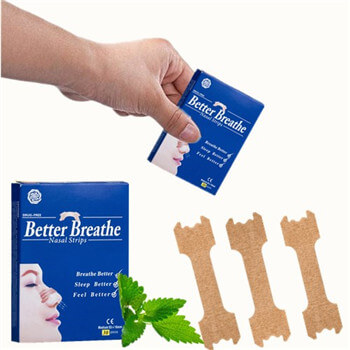Author:Kangdi 03-01-2018
Many people like to use the anti snoring nasal strip now, that little strip of adhesive over the bridge of your nose can in fact engineer increased air-flow through your nostril openings and the interior nasal passages. This little feat of physics seems to provide enough relief to people to make them popular products. The theory on effectiveness is this: if you have problems breathing through your nose at night—and many people do—you will be forced to breathe through your mouth. That can create the right situation in which you might snore. Nasal strips open up nasal passages just enough to make nose breathing comfortable and snoring is stopped.If you snore like a buzz saw or have a bed partner who does, you may have wondered if over-the-counter nasal strips like Breathe Right might actually help. Possibly, if the cause of the snoring is nasal congestion (such as from a cold or allergies) or nasal obstruction (such as from a deviated septum). They may be worth a try, since they are simple to use, noninvasive, and relatively inexpensive; the only risk is skin irritation.
Also called external nasal dilators, they are sort of like stiff Band-Aids, consisting of adhesive tape with hard plastic splints. When you affix one across the bridge of your nose, it acts like a spring to pull your nostrils open slightly so they don’t collapse during inhalation, thus increasing airflow.
A review paper, published in the International Journal of General Medicine in 2014, notes a number of studies showing that anti snoring nasal strips decrease airway resistance and increase nasal airflow during inhalation, while a few small studies have found improvements in snoring in people with compromised nasal breathing or nasal obstruction. The authors of an earlier study in the European Archives of Oto-Rhino-Laryngology that used Breathe Right concluded that the strips may be a good alternative to using nasal decongestants, which have side effects.

 0086 19937104978
0086 19937104978




